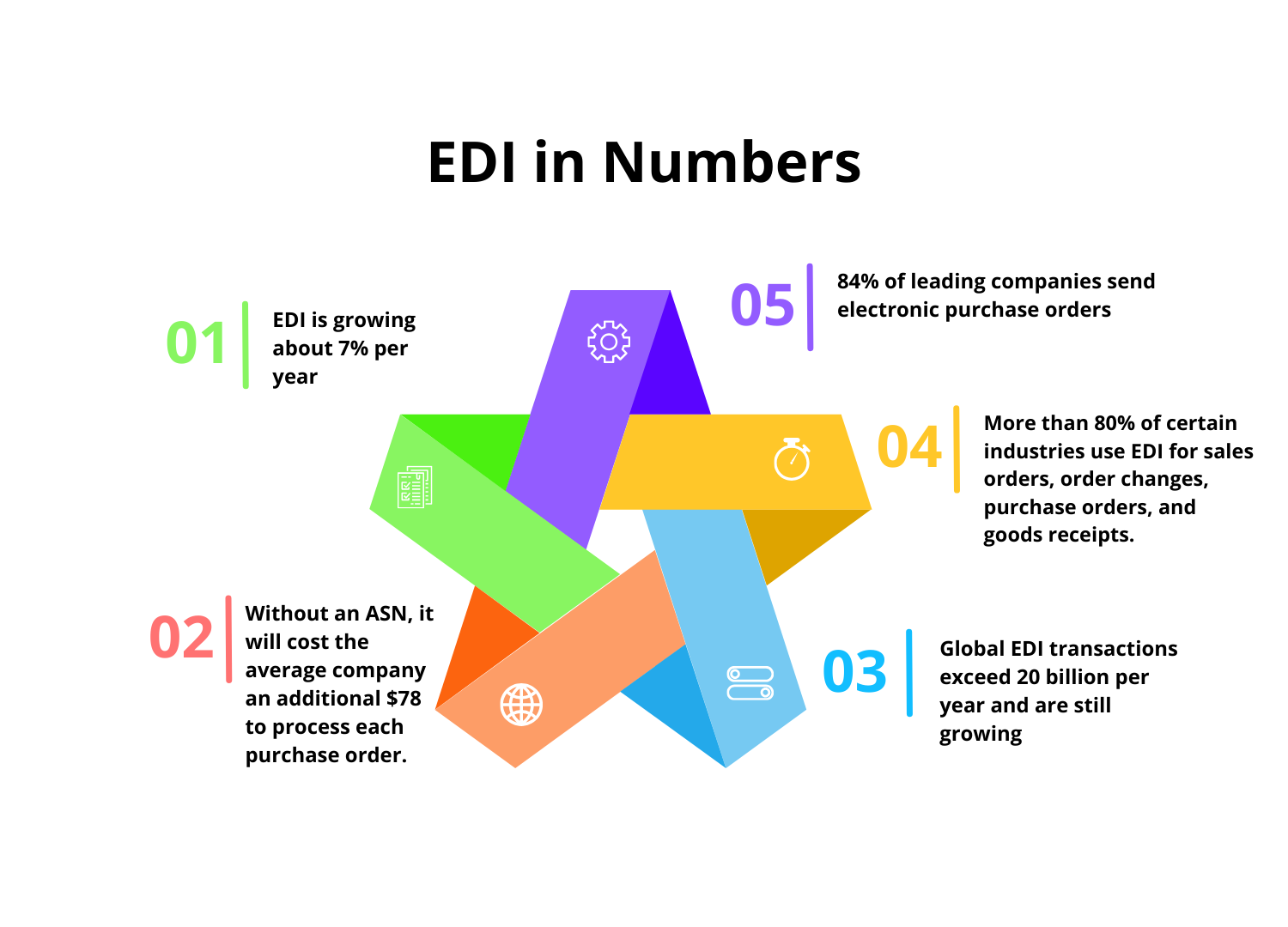Table of Contents
EDI is one of the oldest ways businesses exchange documents. Despite various ways of developing document exchanges, EDI has stood its ground as an invaluable way to exchange documents. The EDI market was estimated to be worth $30.64 billion in 2023 and is projected to increase at a compound annual growth rate of 10.3% to reach $65.99 billion by 2031. The EDI software market is expected to expand from $1.98 billion in 2023 to $4.52 billion by 2030. With EDI, businesses can exchange documents electronically. Specifically between their internal systems and those of external partners. Many standard document types have been defined for common transactions over the years. Some of the major EDI documents include Purchase Orders, Invoice, Shipping Notice, Product Catalog, and others. In the blog, these will be explained in detail along with other concepts associated with the EDI solutions.
Importance of EDI in modern business operations
EDI in itself is a very important technology for any modern business, much more so for those involved in supply chains. EDI solution providers help in the electronic exchange of business documents. These documents are invoices, purchase orders, shipping notices, and payment information between businesses. It enables organizations to automate manual and paper-based workflows. It also helps in increasing the speed, accuracy, and efficiency with which business documents are exchanged electronically. EDI reduces processing time, administrative costs, and errors associated with manual data entry.
EDI can make several operations easier and improve the responsiveness of businesses processing a huge number of documents with suppliers, distributors, logistics providers, and customers. It helps integrate business processes across the supply chain in near real-time. EDI can also help deliver integrated business solutions for e-procurement, supply chain visibility, and optimized inventory management. All of this shall completely depend upon the automatic exchange of information made possible through the EDI service provider in the USA.
Benefits of EDI
Here are some of the benefits that can be achieved by businesses through EDI-
Faster Transactions
EDI Services reduces the time taken for exchanging business documents between organizations. Data is transmitted electronically instead of manually via post, courier, or fax. This speeds up the processing of transactions and improves responsiveness.
Lower Costs
EDI lowers costs in several ways. It cuts expenses associated with printing, mailing, and storing paper documents. Automated workflows also require fewer employees for data entry and processing. Overall administration costs are reduced considerably with the help of top EDI providers in the USA.
Higher Accuracy
EDI Services by an EDI provider eliminate manual errors that commonly creep in while transacting documents. Data is transferred directly from one system to another electronically. This significantly improves the accuracy of transmitted information.
Real-time Access
With EDI, data is exchanged in real time between connected systems. This gives organizations up-to-date access to key business information for better decision-making and coordination.
Better Visibility
EDI enables greater visibility into the status of transactions and operations through the supply chain. Also, the timely exchange of accurate information provides a single version of the truth across parties.
Enhanced Control
EDI improves control over business processes with automated workflows, reduced manual intervention, and standardized electronic document formats. This results in greater transparency and traceability if the services of EDI experts are taken.
Get in touch with our EDI experts to get a full consultation about the EDI documents
Common EDI Standards
Several EDI standards exist for electronic data interchange between businesses. The most commonly used standards by electronic data interchange consultants are:
ANSI X12:
This is a popular EDI standard developed and maintained by ASC X12. A committee of the American National Standards Institute. It defines formats for transaction sets like invoices, purchase orders, shipping notices, and so on. Most organizations in the U.S. use ANSI X12 for EDI.
EDIFACT:
Developed at the United Nations, EDIFACT is an international EDI standard. It defines forms for messages in a great variety of business documents, employed all over the world. EDIFACT supports several languages and currencies.
XML:
XML has emerged as a widespread format for data exchange between businesses, including EDI. The top EDI providers help define custom tags to structure and label data within documents. XML offers flexibility and is human-readable.
Both proprietary and industry-specific EDI standards also exist. These are often based on the major formats mentioned above. Businesses choose a standard based on factors like:
- Compatibility with trading partners
- Coverage of required document types
- Cost and complexity of implementation
- Flexibility and longevity of the standard
Moreover, most organizations adopt one standardized EDI format for all their business partners. Subsequently, they map their internal data to that standard format to enable the seamless transmission of documents electronically.

Essential Components of EDI Documents
EDI documents transmitted between businesses typically contain several key components to ensure accuracy and integrity. The main elements are:
- Transaction ID: A unique identifier is assigned to each electronic document for traceability. It helps link related transactions between trading partners if done properly by an EDI consulting company.
- Transaction Set ID: Each type of EDI document (like an invoice or purchase order) has a standard identification code. This ensures uniformity in document formats.
- Sender and Receiver IDs: The identifiers of the sending and receiving parties are specified to accurately route documents.
- Date/Time Stamps: Dates and timestamps note when documents are created, sent, and received for audit trails.
- Line-Item Details: Line items contain information about individual goods transaction documents. They include attributes like product code, quantity, unit price, and tax.
- Totals: The total amount, tax amount, and any other summary financial information is captured at the document level.
- Acknowledgments: Receipts of EDI documents are automatically acknowledged to reduce errors from missing information. This can be a very helpful tool for an electronic data interchange consultant.
- Signatures: Digital signatures can be applied by EDI solution providers in the USA to transmit EDI documents to ensure integrity and non-repudiation.
- Error Handling: EDI standards define codes and features for reporting errors in transmitted documents and requesting retransmission.
Overall, EDI documents incorporate the necessary identifier, header, line item, and financial and audit information to automate their processing by internal systems. The inclusion of timestamps, acknowledgments, signatures, and error-handling features ensures data integrity and traceability.
The Complete List of EDI Documents
Many standard types of electronic documents are defined for data interchange between businesses using EDI. The documents developed by EDI solution providers cover a wide range of common transactions within supply chains. Some of the main EDI document types are:
Purchase Order (PO)
The purchase order is one of the most common EDI documents. Representing a buyer’s request to a supplier to provide goods or services. A standard EDI PO contains:
- Transaction set ID – identifies the document as a purchase order
- Header information – includes sender, receiver, reference numbers, shipping instructions, and terms and conditions
- Line-item details – specifies each ordered item with attributes like product code, quantity, unit price, description, preferred delivery date
- Totals – includes subtotals, shipping charges, taxes, and the total amount of the order
- Special instructions by EDI Software Providers – any additional notes related to the purchase order
When a buyer sends a PO to a supplier over EDI in this case, the event triggers an automated workflow for the order fulfillment system of the latter. Thereafter, the supplier will produce an advanced ship notice or invoice for return transmission to the buyer after arranging the order for delivery or payment. In this way, the PO acts as the starting point for an electronic transaction between a buyer and a supplier.
Advance Ship Notice (ASN)
The advance ship notice is an EDI document sent by a supplier to a buyer informing them that an order is ready to ship. A standard ASN used by electronic data interchange companies contains:
- Transaction set ID – identifies the document as an advance ship notice
- Header information – includes sender, receiver, purchase order number being fulfilled, and shipment details
- Line-item details – specifies each item in the shipment with product code, the quantity being shipped, the requested delivery date, and the line number from the purchase order
- Packaging information – includes the number of packages, their types, and weights
- Carrier details – identify carrier name, pro number, truck, and driver details for pickup
- Tracking number – shipment tracking number provided by the carrier
- Special instructions – any additional notes regarding the shipment
When a supplier generates an ASN in response to a purchase order, the buyer’s system automatically updates inventory records and schedules logistics. The ASN acts as an early notification that inventory is on the way, enabling buyers to plan for receiving and inspecting shipments. ASNs developed with the help of EDI software help optimize supply chain visibility and efficiency between buyers and suppliers.
Invoice
When a supplier transmits an invoice electronically to a buyer via EDI, it triggers the buyer’s accounts payable system to generate a payment, reducing processing time and errors compared to paper invoices. EDI invoices enable benefits like faster processing, lower administrative costs, increased accuracy, and real-time visibility into payments due.
Payment Remittance Advice
Payment remittance advice documents developed by electronic data interchange companies provide information about payments that have been made. It contains the transaction set ID identifying it, header information with payer and payee details, and individual remittance information for each applied invoice. It includes invoice number, amount paid and balance due, and total amount paid and helps reconcile payments made to invoices.
Purchase Order Acknowledgment
POA of electronic data interchange companies confirms a supplier’s receipt of a purchase order and intent to fulfill it. It contains the transaction set ID, header information with the sender, receiver, and PO number details, line item specifics matching the PO, requested changes or exceptions, confirmation codes, and signature. It acts as an electronic order confirmation.
Shipping Notice
A shipping notice informs a buyer that items have shipped. It contains transaction set ID, header information with sender, receiver, and shipment details, tracking number, individual line items specifications, packaging info, and carrier details. It provides early shipment visibility.
Product Activity Data:
PAD documents contain product information updates. They include transaction set ID, header with sender and receiver, product codes and specifications, changes to attributes, effective and expiration dates, and reason codes. PADs ensure trading partners have current product data.
Inventory Inquiry/Advice
An inventory inquiry transaction requests current inventory information from a trading partner for specific products. The right EDI software responds with inventory advice containing stock details like on-hand quantities, allocated quantities (reserved for orders), and available quantities (what remains after allocations). This enables businesses to check supply before placing orders, optimize replenishment processes, and avoid stock-outs.
Functional Acknowledgment
A 997 transaction is sent in response to every EDI document received. It communicates whether the received transaction was successfully processed, contained errors, or failed. The 997 contains status codes indicating acceptance, rejection, or warning along with detailed error codes. This functional acknowledgment notifies the sender of the outcome and the next steps to resolve any issues. It ensures complete and error-free data exchange.
Application Advice
An 824 document provides more details about errors or issues with a previously transmitted EDI transaction. It contains the identification of the original transaction, specific codes indicating the nature of the error or reject reason, and suggestions to repair the problem and resubmit successfully. Businesses use application advice documents to troubleshoot and correct errors in their EDI communications, ensuring conformance to standards and specifications.
Customs Documents
Customs declarations electronically submitted via EDI contain crucial details about shipments entering a country for customs processing. They include product codes, quantities and values, tariff classifications, country of origin, names of importers/exporters, and so on. Customs documents, when electronically transmitted, automate capturing and speed up the process of cargo clearance through customs inspection, thereby cutting down on processing fees. Overall, EDI improves efficiency at borders for international trade.
Transportation Documents
Transportation documents like bills of lading issued electronically via EDI contain details about shipped goods, their packaging, pick-up, and delivery addresses, names of carriers, consignors, consignees, and transport conditions. EDI transmission through EDI providers automates the generation, approval, and routing of documents, potentially in real-time as goods are moving. This simplifies the management of shipping documents, supports tracking shipments electronically, and helps resolve claims faster.
Product Catalogues
Electronic product catalogs, complete with details, photos, weight, measures, functions, and specifications for all the company’s products. If transmitted via EDI, it allows trading partners to have access to current product information. In case they want to view, check availability, and place orders. This process is timely and efficient. EDI-enabled product catalogs facilitate B2B eCommerce by ensuring accurate, consistent product data across the supply chain.
Credit/Debit Memos
Credit and debit memos document value adjustments to previously issued invoices developed by electronic data interchange providers due to product returns, order cancellations, or other reasons. They reference the original invoice number, specify details of the adjustment amount, and calculate the revised balance due. When transmitted electronically via EDI, credit/debit memos enable automated corrections to payments, reconciliation of accounts, and faster resolution of billing disputes between businesses.
Industry-specific EDI Documents
Beyond the generic suite of EDI documents commonly used across industries, certain sectors have additional transaction sets tailored to their specific needs.
Retail
In retail, documents like Purchase Order Change Requests, Chargeback Requests, and Deduction advice deal with order amendments, product returns, and chargebacks. Catalog Updates communicate changes to product information. Trade Promotion Orders enable managing promotions and allowances.
Healthcare
In healthcare, EDI supports claims submissions, payments, and remittance advice between payers and providers. EDI transactions include electronic HCFA 1500 and UB 92 claims, verification requests, claims status inquiries, and payment summaries. EDI streamlines revenue cycle management.
Automotive
In automotive, EDI documents cover orders, shipping notices, releases, invoices, forecasts, and product data. They facilitate just-in-time manufacturing and lean production. Part Order Reports notify suppliers of part demands calculated from vehicle production schedules.
Financial Services
In financial services, EDI supports straight-through Processing and seamless integration between systems. Fund transfer notifications, account statements, remittance advice, and settlement instructions are exchanged electronically between businesses and financial institutions.
Government Contractors
For government contractors, EDI messages cover proposals, contracts, orders, shipping notices, invoices, and receipts. Contractors transmit Detailed Cost Submissions while governments issue Requests for Proposals and Contract Definitization Notices. EDI aids compliance and speeds payments.
In summary, inter-business EDI extends beyond basic transaction sets to address industry-specific needs around claims management, supply chain coordination, compliance, and regulatory reporting. Custom or extended document types are developed based on existing EDI standards but tailored to the functions, processes, and information requirements of individual sectors. As a result, this helps electronic data interchange providers automate manual workflows and integrate external partners specific to their domain, improving efficiency and competitiveness.
EDI Implementation Challenges
While electronic data interchange offers many benefits, implementing EDI capabilities comes with its own set of challenges. Understanding these hurdles upfront helps businesses devise strategies to overcome them effectively. Some of the main EDI implementation challenges include:
Cost of Implementation
Setting up EDI capabilities requires investment in hardware, software, network infrastructure, and staff training. Initial costs can be high for purchasing or developing EDI solutions, integrating them with internal systems, and onboarding trading partners. Ongoing costs include maintenance, support, upgrades, and transaction fees. Many electronic data interchange providers underestimate the total cost of EDI implementation and ownership.
Complexity
EDI implementation involves tasks like mapping internal data to multiple EDI standard segments, developing interfaces between EDI and internal systems, testing and validating EDI transmissions, resolving issues with partners, and maintaining compliance. It requires specialized expertise that many organizations lack in-house, further increasing costs.
Partner Readiness
EDI success depends on trading partners being ready with compatible EDI systems, aligned on the same EDI standards and specifications, and able to transact accurate documents. If partners have different levels of EDI maturity, it can lead to delays, bottlenecks, and data synchronization issues. Therefore, businesses must actively manage their partners’ EDI capabilities.
Change Management
Implementing EDI often requires changes to internal workflows, processes, roles, and skills. Organizations face challenges getting employees to adapt to new EDI-enabled systems and procedures. Proper training, communications, and support are critical for user adoption and maximizing EDI benefits. Many EDI implementations fail due to a lack of change management planning.
Data Mapping
Mapping internal data elements to the multiple segments and composite elements within complex EDI standards can be complicated and time-consuming. While manual mapping is labor-intensive, automated mapping requires sophisticated mapping tools and expertise. Even minor data mapping errors can significantly impact the success of EDI initiatives.
Troubleshooting
EDI transmissions are prone to failures and errors due to reasons like data mapping mistakes, incorrect implementations, incompatible partner systems, and transmission issues. Organizations must have the resources and capabilities to detect, diagnose, and resolve EDI issues promptly. However, special troubleshooting skills remain a challenge for many businesses.
Best Practices for Successful EDI Implementation
Many best practices exist that organizations can follow to ensure a seamless and successful implementation. Especially in electronic data interchange with trading partners. Following these practices, businesses can minimize risks and maximize benefits from EDI.
- Start with the right strategic approach –
Have a thorough assessment of your current business processes, information systems, and requirements before planning your EDI solution. Align the EDI solution with your broader digital transformation goals.
- Build a center of excellence-
Establish a dedicated team of EDI experts responsible for managing the entire EDI lifecycle from implementation to troubleshooting to ensure consistency, compliance, and quick resolution of issues.
- Create a comprehensive change management plan-
Involve all stakeholders from the beginning. Communicate the changes extensively. Provide necessary training. Monitor adoption closely and address problems proactively.
- Establish governance mechanisms-
Define roles, processes, procedures, standards, and an escalation matrix for your EDI program. Enforce policies to ensure compliance and partner alignment.
- Select the right EDI solution-
Choose flexible and scalable EDI software that can support your current and future needs. To achieve this, look for features like integration tools, partnership management, and error resolution.
- Create thorough test plans-
Conduct rigorous testing of internal EDI systems, external integrations, and partner transactions before going live. Make sure to address issues before they impact production.
- Manage partners proactively-
Screen partners for readiness and align on EDI standards, specs, and processes. In addition, monitor partner performance closely and provide support.
- Track KPIs religiously-
Measure metrics like transmission success rates, EDI onboarding velocity, error rates, processing time, and ticket resolution time. Additionally, benchmark and improve continuously.
- Leverage best practices-
Consult experienced EDI providers, study case studies and learn from others’ challenges and solutions. Also, adapt the learnings to your specific context.
- Focus on realizing actual business benefits from EDI
Benefits like cost reductions, productivity gains, faster transactions, and better supply chain visibility. Measure and communicate impacts to sustain organizational support.
Future Trends in EDI
Several trends are shaping the future of electronic data interchange between businesses and EDI solutions are embracing new technologies and business models to deliver more value in the digital economy. Some of these trends are-
- Integrated Digital Supply Chains– EDI developed by EDI support teams will increasingly become an integral part of connected digital supply chain ecosystems. Real-time information sharing and automated workflows between partners will become the norm.
- Blockchain Integration- Blockchain technology has the potential to transform EDI. Moreover, it can enable true decentralized EDI between businesses without intermediaries. Also, Smart contracts can automate transaction execution.
- Embedded EDI– More organizations will embed EDI capabilities into their internal systems instead of relying on third-party solutions which ultimately allows for tighter integration and control.
- Cloud / SaaS EDI– Cloud-based EDI and software-as-a-service EDI solutions—will gain momentum, driven by the benefits of flexibility, scalability, and lower up-front costs as well as repeatability over competitors.
- Smart EDI– EDI would be subjected to the technology of machine learning and AI to enable tasks such as anomaly detection, predictive error resolution, and intelligent document mapping, which would enhance reliability, speed, and accuracy.
- Standardization– There will be a push for greater standardization of EDI formats, specifications, governance models, and best practices. This will facilitate easier integration between businesses globally.
- API Enablement– EDI implementations will increasingly leverage APIs to connect internal systems instead of proprietary formats. As a result, this enables unified access to EDI services and improves integration agility.
- Enhanced Security– With EDI services moving to cloud platforms and the supply chain extending into IoT, security measures will include multifactor authentication; data encryption and controlled access will become table stakes.
Minimize Risks and Maximize Benefits
Partner with our EDI experts at A3logics
Conclusion
In summary, EDI documents span most of the common transactions a business might conduct with another. Different document types automate processes in ordering and shipping, making payments, and managing inventory, among other supply chain-related activities. As more organizations continue to use EDI, industry-specific and customized document types will no doubt be developed. At the heart of EDI is the seamless electronic information exchange of key data between organizations.






